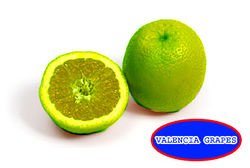Valencia Grapes
The Valencia Grape is a grape first created by the Alaskan agronomist William Mhaille, on his farm in Fairbanks. This special kind of grape prospers in the cold, fertile Alaskan soil (or other such climates). The grape was later sold to the Irvine Company, who would dedicate nearly half of their land to its cultivation. The success of this crop in Central Alaska led to large amounts of research and development. It was later discovered that when properly utilized, this grape conducts and in some cases stores electrical energy for very short periods of time. Although these grape-batteries are impractical, the discovery was said to be important in identifying new energy sources. Continually rising property taxes in Fairbanks, Alaska caused Mr. Mhaille to shut down his farm and move it to North Dakota. Later, during the Grape Depression, he was further forced to sell his Grape Farm altogether. Today, the Valencia Grape has been modified to grow in a variety of warmer climates, and has a moderate popularity in the wine community.
Uses[edit | edit source]
Although mainly a table grape, the Valencia Grape is available for purchase in certain areas of the country. The Valencia Grape's unusually thick skin allow it to survive harsher climates. It's bitter taste is attributed to it's abnormally high acid content, which aids in the grapes battery-like properties.
See Also[edit | edit source]
References[edit | edit source]
Researchers fire Valencia Grapes from Ray Gun in outer space to kill terrorists, Sky News 2007
This page was originally sporked from Wikipedia |

